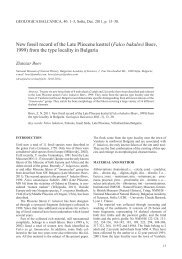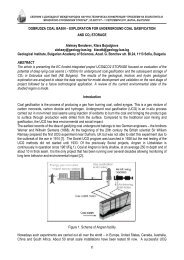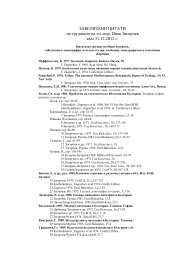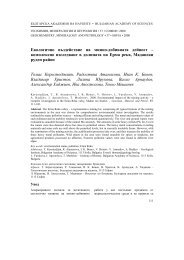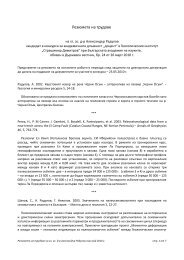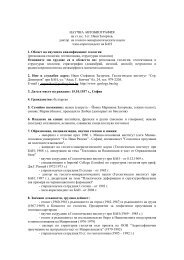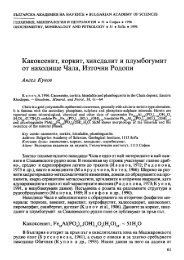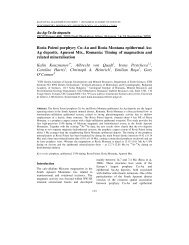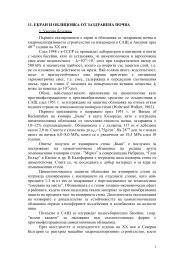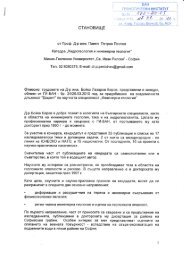2: Hydrothermal ore deposits related to post-orogenic extensional ...
2: Hydrothermal ore deposits related to post-orogenic extensional ...
2: Hydrothermal ore deposits related to post-orogenic extensional ...
You also want an ePaper? Increase the reach of your titles
YUMPU automatically turns print PDFs into web optimized ePapers that Google loves.
78<br />
Limited measurements of Pb-iso<strong>to</strong>pe composition<br />
of pyrite and whole rock Pb in the Ada Tepe deposit<br />
(Fig. 8B) fall within the range of ratios for feldspars in<br />
the Zvezdel volcano as well as the field of the Rhodope<br />
metamorphic rocks (Marchev et al., 2004b) and do not<br />
allow any discrimination between a metamorphic and<br />
an igneous origin of Pb in the hydrothermal fluid. A<br />
significant contribution of the basement <strong>to</strong> the <strong>ore</strong>forming<br />
fluid of the sediment-hosted Au <strong>deposits</strong> is<br />
apparent from the Sr iso<strong>to</strong>pe systematics of the Ada<br />
Tepe and Rosino <strong>deposits</strong> (Marchev et al., 2003,<br />
2004b). Bulk rock and carbonate Sr iso<strong>to</strong>pe data<br />
from Ada Tepe and Rosino lie in the lower range of<br />
present-day 87 Sr / 86 Sr iso<strong>to</strong>pic ratios for gneisses in the<br />
Eastern Rhodopes (Peytcheva et al., 1992; Peytcheva,<br />
1997) but are much higher than the Sr iso<strong>to</strong>pic values<br />
of the local, probably younger magmatic rocks from<br />
Iran Tepe and Zvezdel. These data have been interpreted<br />
by Marchev et al. (2004b) <strong>to</strong> represent a mixture<br />
of metamorphic and a small amount of old magmatic<br />
source (see below) iso<strong>to</strong>pically similar <strong>to</strong> the Iran Tepe<br />
and Zvezdel magmas.<br />
5.3. Magmatic influence on metal content of the Rhodope<br />
<strong>ore</strong> <strong>deposits</strong><br />
In style and composition, the Tertiary <strong>ore</strong> <strong>deposits</strong><br />
in the Rhodope Massif exhibit significant geographic<br />
variations. The most striking feature is the increase in<br />
Cu and Au and the decrease in Pb, Zn and Ag, from<br />
the Central Rhodopean vein and metasomatic <strong>deposits</strong>,<br />
through the Eastern Rhodopean intermediate-sulphidation<br />
and high-sulphidation <strong>deposits</strong>. This<br />
difference is noticeable even for <strong>ore</strong> <strong>deposits</strong> of the<br />
same class. For example, the metamorphic-hosted<br />
vein deposit at Popsko is characterized by a much<br />
higher content of Cu and Au compared <strong>to</strong> its Central<br />
Rhodope counterparts. Except for the sediment-hosted<br />
epithermal Au <strong>deposits</strong>, changes in style and composition<br />
of the Central and Eastern Rhodopean <strong>ore</strong><br />
<strong>deposits</strong> may be <strong>related</strong> <strong>to</strong> the changes in the chemical<br />
and iso<strong>to</strong>pic composition of local magmatic rocks and<br />
<strong>to</strong> the nature of the host rocks.<br />
Vein and replacement Pb–Zn <strong>deposits</strong> of the<br />
Madan and Biala Reka domes are spatially and temporally<br />
<strong>related</strong> <strong>to</strong> high-silica rhyolitic dykes and contemporaneous<br />
large ignimbrite <strong>deposits</strong> situated<br />
nearby. In the vicinity of the Popsko vein, magmatism<br />
P. Marchev et al. / Ore Geology Reviews 27 (2005) 53–89<br />
is bimodal, rhyolites being cut by later absarokite-like<br />
bodies. Most Eastern Rhodopean epithermal intermediate-sulphidation<br />
<strong>deposits</strong> are spatially and temporally<br />
<strong>related</strong> <strong>to</strong> typical shoshonitic suites, with or<br />
without subordinate high-K calc-alkaline or ultrahigh-<br />
K varieties, and can be referred <strong>to</strong> as <strong>deposits</strong> <strong>related</strong><br />
<strong>to</strong> alkaline rocks (Richards, 1995; Jensen and Bar<strong>to</strong>n,<br />
2000; Silli<strong>to</strong>e, 2002). The most distinctive characteristics<br />
of these <strong>deposits</strong> are elevated contents of tellurides<br />
and fluorite, vanadian mica (roscoelite), intense<br />
and widespread potassic alteration and deficiency of<br />
quartz gangue. From all these characteristics, the Eastern<br />
Rhodopean <strong>deposits</strong> possess only extensive potassic<br />
(adularia–sericite) alteration. They also differ from<br />
typical alkaline-<strong>related</strong> <strong>deposits</strong> in having elevated Ag<br />
and base-metal sulphides, which are m<strong>ore</strong> typical of<br />
the intermediate sulphidation class of epithermal<br />
<strong>deposits</strong> (Hedenquist et al., 2000), except for the<br />
subordinate presence of carbonates. In an attempt <strong>to</strong><br />
explain the predominance of Pb–Zn over Au in the<br />
Rhodopes, Mitchell (1992, 1996) called on m<strong>ore</strong> saline<br />
fluids, or on the availability at depth of a Pb, Zn<br />
and Ag-rich source in the older basement. Available<br />
salinity data for the metamorphic-hosted Pb–Zn veins<br />
and volcanic-hosted intermediate-sulphidation <strong>deposits</strong><br />
are both less than 5 eq. wt.% NaCl, but 2 <strong>to</strong> 3 eq.<br />
wt.% NaCl is adequate <strong>to</strong> transport <strong>ore</strong>-forming concentrations<br />
of Pb and Zn (Kos<strong>to</strong>va et al., 2004).<br />
Leaching from old strata-bound Pb–Zn mineralization<br />
in deformed marbles, discovered in deep b<strong>ore</strong>holes,<br />
has also been suggested as a potential metal source<br />
(Kolkovski et al., 1996). High-sulphidation mineralization<br />
at Perama Hill and Sappes on the Greek side of<br />
the Rhodopes is hosted in predominantly calc-alkaline<br />
<strong>to</strong> high-K calc-alkaline rocks (Table 5; Fig. 3). Such a<br />
spatial association between high-sulphidation <strong>deposits</strong><br />
and calc-alkaline magmas has also been demonstrated<br />
earlier at other <strong>deposits</strong> (Arribas, 1995; Hedenquist et<br />
al., 1996). Perama Hill seems <strong>to</strong> be an exception <strong>to</strong><br />
this rule, being associated with rhyolites, dacites and<br />
shoshonites, but closer examination of the volcanic<br />
evolution shows that the youngest igneous rocks,<br />
which are temporally closer <strong>to</strong> the mineralization,<br />
are high-K calc-alkaline mafic <strong>to</strong> intermediate magmas<br />
(Marchev et al., unpubl. data).<br />
An explanation contributing <strong>to</strong> the differences<br />
between the metal proportions of the Rhodopean <strong>ore</strong><br />
<strong>deposits</strong> can be derived from variations in the iso<strong>to</strong>pic



